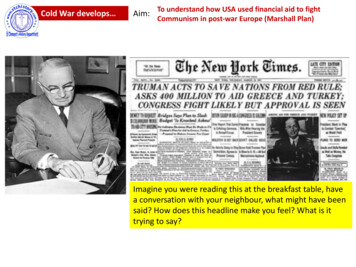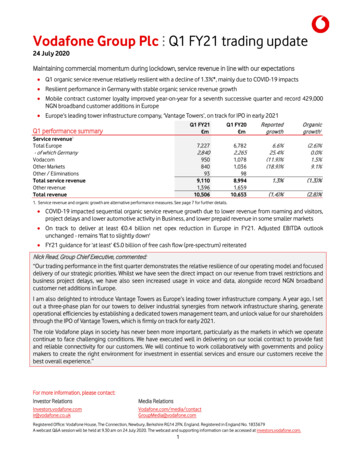
Transcription
TIM-DCB rev. 06/2016B.M.P. EuropeHigh Performace DoorsDynamicroll CB BasicInstallation, Use and Maintenance Manual – EN
123455.15.25.35.45.55.65.7678910Safety precautions Technical features Mechanical Installation Electric diagram – Components layout Control unit Connections to supply and automation Connections to commands and safety devices Manual Jog and display Position and closing time adjustment with encoder Position and closing time adjustment with limit switches Pedestrian opening adjustment Interlock Safety devices Use instruction Maintenance instruction Alarms list Running options list 1General Safety precautionsThis manual is aimed exclusively at installers and technicians professionally competent. All operations of mechanicalinstallation, electrical connections and adjustments must bemade respecting the good workmanship and applying all thesafety rule in force, even if their indications were not explicitin the text of the instructions.Before starting the installation of the door read the instructions carefully. Incorrect installation can be dangerous.Before beginning the installation check perfect condition ofthe product.Before installing the door, Ensure that the floor, thewalls or the existing support structure have the necessarystrength, capable of supporting the weight of the door, alsoconsidering the dynamic forces due to normal operation andthe eventual impacts. If necessary make modification to thestructures before the door installation. Verify that the structure is suitable to protect or isolate all the areas affected bythe danger of crushing, trimming, trapping and general danger.Automation is equipped with the necessary safety devices to ensure compliance with product standards. Thesedevices (photocells, safety edges, emergency stop, etc.)Must be connected according to current regulations and directives in force, good workmanship criteria, the installationenvironment, the operating logic of the system and forcesdeveloped by the door. Display the signs required by law toidentify danger areas. Each installation must clearly showthe identification data of the door.Before connecting the power supply, check that thedata on the label correspond to the electricity distributionnetwork. A mains power switch properly sized must be installed before the control board inlet. Check that the powerB.M.P. Europe23467789101112121314151617line is protected by RCD and overcurrent protection. Connect the door to an efficient grounding system.The manufacturer of the door declines all responsibility if components which are incompatible with the safe andcorrect operation or when changes are made of any kindwithout the specific permission of the manufacturer. Onlyoriginal spare parts shall be used for repairs or replacementof components during maintenance or service.The installer must supply all information relating to automation concerning manual and emergency operations andprovide the user the Instructions for Use.After installation, packaging materials (plastic, cardboard, etc.) must not be allowed to litter the environment.This document was issued by the Manufacturer withthe utmost care, in any case the Manufacturer does notaccept responsibility for any damage caused by errorsor omissions in this publication. We reserve the right tochange the contents without notice. No rights can bederived from the contents of this document. It is prohibited to copy or otherwise publish by any means without written permission of the manufacturer.All rights reserved.TIM-DCB rev. 06/2016 2
2Installation drawing and technical featuresDynamicroll CB BasicInverter automation230 V – BMP1 V3400 V – BMP2 V3Main supply230V AC single phase400 V AC threephaseFrequency50/60Hz50/60HzCurrent absorption main supply16A10AMotor power0,75 - 1,5kW0,75 - 1,5kWControl board protection degreeIP65IP65Motor protection degreeIP54IP54Functioning temperature rangefrom -20 C to 50 Cfrom -20 C to 50 C* in case of environment artificially refrigerated, with negative temperature, use heating system for guides and geared motor.Design main supply lines respecting the correct sizing criteria, considering the expected maximum absorption: 16A for single phase control panels and 10 A for those three-phase.The sections used must be chosen according to the length of the lines and their installation condition, toavoid voltage dropping and consequent improper functioning.B.M.P. EuropeTIM-DCB rev. 06/2016 3
3Mechanical installation123D1 Fix the columns to heading through the brackets.When the doors are larger than 4000 4000 fit before theposts to the wall, and then install the crosspiece.2 Take care the level between the support and after fixingof the posts control the geometry (diagonal).3 Complete the mounting by the supplied brackets D andany additional anchorages where necessary. When L 4000fit additional supports every 2 m.B.M.P. EuropeTIM-DCB rev. 06/2016 4
454 Drill the holes in the axis of the slots, so then perform thenecessary final adjustments.5 Fit the counterweight (optional) and adjust the fitting at50 mm from the floor at opened door.B.M.P. EuropeTIM-DCB rev. 06/2016 5
4Electric diagram – Components layoutComponents listCablingSectionsCControl board1Motor and brake supply cabling4 1,5 mm2MThree phase geared motor2Control board/Mobile connector cable7 0,5 mm2SSignals distributor connection (spider)3Mobile connector/Distribution connection7 0,34 mm2BElectro-brake4Encoder cable4 0,34 mm2JCurtain jamming sensor5Curtain jamming sensor cable3 0,34 mm2RInfrared photocell receiver6Photocell receiver cable3 0,34 mm2TInfrared photocell transmitter7Photocell transmitter cable3 0,34 mm2HSafety edge radio band transmitterB.M.P. EuropeTIM-DCB rev. 06/2016 6
5Electronic board5.1Supply and power connectionsBMP2 – V3 (400V)Connect to the transformer inlet correspondingto the real supply voltageBMP1 – V3 (230V)Connect to the transformer inlet correspondingto the real supply voltageConnect the shield of the motor cable to the groundterminal.* Verify that the motor programmed in "system parameters setup" matches the nameplate data of theinstalled type.TerminalDescriptionBMP1 V3BMP2 V3P-N / R-S-TMain supply230 V AC400 V AC12VSignal SUPPLY FROM UPS12 V DC12V DC VB -VBSupply bus from UPS (optional)320 V DC560V DCU-V-WThree-phase motor230 V – 0,75 / 1,5 kW400V – 0,75 / 1,5 kWLMP - 29 30Flashing lamp230 V AC [RMS]230 V AC [RMS]BRK - 30 31Brake110 V DC [RMS]110 V DC [RMS]F1Fuse10 A (230 V)–LD0Capacitor discharging signaling––B.M.P. EuropeTIM-DCB rev. 06/2016 7
5.2Controls and safety inputsDIP-Switch SW1DIP 1 Control typeDIP 2 Brake typeONAutomatic closingActive brake (only with counterweight)OFFControl step by stepStandard brake (negative)TerminalDescription1 12 V common20 V common3Not used (serial com)4–5Output: Close Contact at closed door (voltage free contact RL1)6 12 V common7Curtain jamming SensorLD138Open command (external command by accessorries)LD129Safety edge or light curtain (photocell barrier)LD1110Opening command from UPSLD1011Start command (push button)LD912Pedestrian opening commandLD813 12 V common14Photocell Signal15 12 V common16StopLD617Encoder channel A or Opening approaching limit switchLD518Encoder channel B or Closing approaching limit switchLD419Opening limit switch (if limit switches set)LD320Closing limit switch (if limit switches set)LD22124 V AC Accessories supply2224 V AC Accessories supply32–33Output: Close Contact at opened door (voltage free contact RL2)B.M.P. EuropeSignalling LED12V for safety devices and encoder.Do not use to supply optional accessories.LD7TIM-DCB rev. 06/2016 8
5.3Manual JOG and DisplayButtonActionDescriptionP1Jog OPENSERVICE command in openingP2Program modeProgramming mode pushing for 5 secondscommand(until LD1 flashes quickly)P3Jog CLOSEService command in closingI digitII digitDescriptionAL00 00Door in standby, wating Jog commandJJog mode activatedJoManual open (Jog open)JcManual close (Jog close)CLDoor in closing (CLosing)OPDoor in opening (OPening)CDoor closed (Closed)ODoor opened (Opened)tEEncoder programming activated (teaching Encoder)tSElectromechanical switches programming (teaching Switch)tPPedestrian opening programming (teaching Pedestrian)toOpening time (timing opened)PEPedestrian opening position (PEdestrian)StStop button activated (Stop)EAEncoder in alignmet (Encoder Alignment)ALAlarm (ALarm) list at page 14UPSEmergency supply activated (UPS)0 99Break timing (count down)–Pausa 0 time (start the closing)HHIncorrect encoder alignement after a shutdownB.M.P. EuropeTIM-DCB rev. 06/2016 9
5.4Adjustment and programming (Encoder)Check the correct rotation direction of the door,eventually adjust it with thesupply sequence (U V W).ActionDisplayLD1LD71.a Drive the curtain in closed door by P3JcOFFOFF1.b Check the photocell engagement by led LD7 OFFJOFFOFFPush P2 for 5 second until LD1 flashes quiklytEFlashingOFF2.a Drive the curtain in opened door by P1. Check the bottom edge,it must be at least 50 mm over the reinserting cut into the guideJoFlashingOFF2.b Push P2 (impulsive)tEFlashingONWait the needed break timetEFlashingONPush P2 (impulsive) giving the closing commandtEFlashingONThe door will close up to the photocell engagmentCFlashingOFFGive a command OPEN/START to check the complete cycleOP12Programing of the closed door positionProgramming of the opened door position and break time1.a2.aOPEN1.bB.M.P. Europe2.bTIM-DCB rev. 06/2016 10
5.5Adjustment and programming (Limit switches)Ref.Wires colorDescriptionTerminalLed1GreenOpened door19LD32WhiteSlowing in opening17LD53GreySlowing in closing18LD44BrownClosed door20LD2CYellowCommon ( 12 V)15-1 Limit switches adjustment– Check the right door movement (up/down) and in case correct by the phase sequence (U V W)– Adjust the cams position as per the indication into the drawing2 Programming the break time2.a Drive the door at closed door by P32.b Push P2 for 5 seconds until LD1 flashes quickly2.c Push Start to open the door– Check the bottom edge, it must be at least 50 mm over the reinserting cut into the guide– Wait the needed break time– Push Start to close– The door close completely– Give a command OPEN/START to check the complete cycle2.a2.cSTARTTIMERSTART2.bB.M.P. EuropeTIM-DCB rev. 06/2016 11
5.6Pedestrian opening ajustmentA Pedestrian opening with Encoder system– Connect the pedestrian command between the terminals 13-12– Drive the door in closed door position by P3– Open the door by P1 up to the needed pedestrian passage position– Start the programming, pushing P2 for 5s (LD1 flashes quickly)– Give a command for pedestrian opening (13-12)– Wait the needed break time– Give a command for pedestrian pasSage (13-12) to save the timingB Pedestrian opening with limit switches system– Connect the pedestrian command between the terminals 13-12– Drive the door in closed door position by P1– Start the programming pusing P2 for 5 s (LD2 flashes quickly)– Open the door by P1 up to the needed pedestrian passage position– Give a command for pedestrian opening (13-12)– At the needed position give a pedestrian opening command (13-12)– Wait the needed break time- Give a command for pedestrian passage (13-12) to save the timing5.7InterlockBy the LCD programmer:- go into the menu INPUTS STATUS DISPLAY- modify the parameter REMOTE START TERMINAL from 00 to 19To have the automatic command of the second door:- go into the menu SYSTEM PARAMETERS SETUP- modify the parameter RUNNING OPTION adding 80.000 (e.g. if the value was 4200 84200)B.M.P. EuropeTIM-DCB rev. 06/2016 12
6Safety devices6.1Infrared photocellThe photocell sensors mustbe fitted as per the drawing,so when the curtain is closedthe photocell will be engaged.Signalling by LD7.ATTENTION In case of Encoder system, the photocellmakes the alignment.It cannot be disconnected.6.2Curtain jamming sensor (optional)The curtain jamming sensordetects the mis-unrolling ofthe curtaing in closing.Adjust the positioning into theoval slot and the sensibility bythe relevant trimmer.Signaling by LD13.If the sensor isn't foreseenbridge 7–13.6.3Wire-less safety edgeConnect transmitter and receive as per the diagramif the safety edge isn't foreseen bridge 9-15Signaling by LD11B.M.P. Europe1. Supply the receiver (greenled ON) and insert the batteries into the transmitter2. The pre-coupled system isactive. Test the correct functioning pushing the edge.If necessary program thetransmission:a. Push the button SAFETYon the receiver. The memoryremains open for 10s (red ledON)b. push the safety bar to memorize the transmitter codec. the red led flash for 3seconds for right programmingInsert the transmitter into thebottom edge pocket.TIM-DCB rev. 06/2016 13
7Use instructionsGENERAL SAFETY PRECAUTIONThis manual is an integral and essential part of the product and must be delivered to the final user. The owner mustkeep this document and pass on to subsequent users of thesystem. The automation in question is a door with verticalmovement, will be used for the purposes for which it wasdesigned. Any other use is considered improper and dangerous.The manufacturer is not responsible for damage caused byimproper, incorrect or unreasonable use.USE PRECAUTIONS- Do not enter the operating range of the door during movement.- In case of breakdown or malfunction switch off the mainswitch. Maintenance, adjustment and repair must be performed only by trained and authorized personnel.- Each automation is accompanied by "Installation and maintenance", in which among other things shows the periodicalmaintenance plan, in particular, it is recommended to checkall the safety devices.Controls on the control panel- GS: General switch of the main supply, disconnects thepower equipment. Operate only in case of need for maintenance or repair.- Stop: Stop immediately each movement of the drive.Button with restraint: turn to the right to free- Start: Opening control and start the cycle of automaticdoor.Manual operationTo operate the curtain in case of power failure or breakdown:- Switch the GS to disconnect the main supply- Insert the rod coupling in the lower side of the motor,thereby actuating the micro switch that prevents electricaloperation of the door.- Turn the handle until you reach the desired position of thecurtain.B.M.P. EuropeTIM-DCB rev. 06/2016 14
8Maintenance instructionsOperations to be carried out every six months during themaintenace inspections:Safety devices:– Check the proper functioning of the safety edge (whereprovided)– Check the functioning of the curtain jamming sensor(where provided)– Check the functioning of the safety photocellAutomation:– Check the functioning of all the control devices installed(push buttons, radar, magnetic loop etc.)– Check the electric connections on pugs and terminals,verifiy that there are no water leaks or dust.- Check the wear of the electrical components and their insulationMotorization:– Check the tightness of the motor fitting– Check the operation of the encoder or limit switches(check the wear of the cams)– Check the wear of the brake disc and verify the brakingefficiency.Winding barrel:– Check the fixing of the rolling bearings– Check the bearing lubrication– Check the alignment of the winding barrelSide guides, curtain and frame:- Check the wear of the side guides.Do not lubricate: guides and zippers are made of self-lubricating materials.The use of oil, grease or other lubricants creates with timethe jam of the sliding.- Check the tension of the curtain (see instructions on p23)- Check tightness of the coupling screws of the uprightswith transom- Check the anchor of the door to the building/structureIt is necessary to perform periodic inspections by qualifiedtechnicians. All operations must be carried out in full compliance with safety regulations, defining and highlightingthe area of operations. Before any operation disconnect theelectrical supply line by means of the main switch and prevent it can be restored by third persons.B.M.P. EuropeTIM-DCB rev. 06/2016 15
9Alarms list** The Following list is valid from firmware version 1.15.0408, for earlier issues see previous instructions manuals.AL displayAlarm descriptionSolutionStStop EngagedDisingage the STOP push button (red mushroom)HHIncorrect encoder alignmentMake the position alignment00 01Short circuit on the control boardCheck or replace the control board00 02Failure initial setupCheck or replace the control board00 03Failure to main capacitor chargingCheck or replace the control board00 04Over-temperature threshold exceededCheck motor absorptions and duty cycle00 05Instant current threshold exceededCheck motor absorptions and parameters adjustment00 11Overload current (brake/flashing lamp)Check brake/flashing lamp and relevant connections00 12Overload current (motor)Check motor current, winding and relevant connections00 50Brake circuit opened, current 0Check brake, connections or manual rod safety switch00 71Opening slowdown limit missingMove the door by jog button P1-P3 (encoder) or check0072Closing slowdown limit missingthe limit switches00 73Jog buttons ON togetherCheck push button P1 and P300 74Curtain jamming failureCheck curtain sliding and adjustment of jamming sensor00 75Slowing limit switch engaged togetherCheck slowing limit switches00 76Main supply undervoltageCheck main supply voltage and line section dimension00 77Stop engagedDisingage the STOP push button (red mushroom)00 78Manual rod safety switch engagedCheck the manual rod safety switch00 79Safety edge engagedCheck the devices aand relevant connection00 80System failureUpdate the firmware or replace the electronic board00 87Over voltage during closing movementDecrease the speed in closing (frequency)00 88Motor over-currentCheck value RUN MODE 60, remake alignment00 89Brake or flashing lamp over-currentCheck value RUN MODE 60, remake alignment00 8BBrake or flashing lamp over-currentCheck value RUN MODE 60, remake alignment00 8DOver-temperatureDecrease the duty cycle, increase the breaking time00 8FSystem failureUpdate the firmware or replace the electronic board00 91System failureUpdate the firmware or replace the electronic board01 00Gear box reduction ratio incoherentGear box incorrect or encoder resolution problem01 02Encoder connection failureCheck the encoder and its connections01 03Alignement started with photocell notengagedCheck the photocell at closed curtain (led LD7 OFF)01 05Photocell disingaged at once in alignmentCheck eventual disturb or photocell low positoned01 08Opened position set with engaged photocellRemake the alignment01 09Opened position too lowRemake the alignment01 0DPedestrian opening position 0Remake the alignmentB.M.P. EuropeTIM-DCB rev. 06/2016 16
AL displayAlarm descriptionSolution01 0EEncoder counting failure or motor stallingCheck the functioning of encoder, motor and brake(dicrease speed or increase acceler. ramp open)01 0FPhotocell trouble during alignmentCheck the photocell functioning (led LD7)01 10Photocell failure during alignmentCheck the photocell functioning (led LD7)01 14Remote keybord disconnected (model Easy)Check the keyboard connection and led status01 15Encoder signals failureCheck encoder and connections (led LD4 - LD5)01 16Wrong motor parametersCheck the motor parameters matching the label datas10 Running optionsTo set the options in use by the programmer enter the menu SETTING PARAMETERS and enter the value of the request parameter RUNNING OPTIONS. The factory default setting 00000200 In case of encoder system after the first jog movementthe value became automatically 00004200.ValueDescriptionRemarks00000002 Enables UPS (opt) for manual opening in case of supplybreak-downAutomatic opening after a presetted time00000004 Enables UPS manual opening by supply break-downOpening after a START command00000008 The Start make command CLOSEDisables the START as command OPEN00000010 Enables the cycle step by stepPedestrian startThe Start command open/close, during the00000020 Enables the time after a transitIf option 20 disabled only the breaking time00000040 Move pedestrian opening to command OPEN (8)To be used in case of pedestrian UPSclosing Start give stop to the motion00000100 Disables brake current control before the starting00000200 Disables timeout and incherences controlsDefault setting00000400 The pedestrian command set OPEN, but not CLOSEOnly break time reset00001000 Anti-icing AStart each 15 minutes00002000 Anti-icing BStart each 60 minutes00003000 Anti-icing CAdjustable timer in seconds by the time aftertransit from the photocell00004000 Encoder automatically recognized by the first jogmovementAutomatic setting00080000 Enables interlockingConnect the doors as explained at page 1200100000 Disables automatic alignment after a supply breakdownTo get the alignment give a Start00200000 Enable the motor warming by currentTo be used only at low temperatures00400000 Enables relay was opening door pedestrianDisable the relay in total opening01000000 The external control (8) active only during closureInput 8 disabled at closed door10000000 Increase engine torque in closingFor use with counterweightEXAMPLE – to activate the ANTI-ICING A function add 1000 to the number in OPTION IN USE, if the existing number is 4200(deactivate timeout encoder control), add 1000: the final value will become 5200B.M.P. EuropeTIM-DCB rev. 06/2016 17
1 Programing of the closed door position 1.a Drive the curtain in closed door by P3 Jc OFF OFF 1.b Check the photocell engagement by led LD7 OFF J OFF OFF Push P2 for 5 second until LD1 flashes quikly tE Flashing OFF 2 Programming of the opened door position and break time 2.a Drive the curtain in opened door by P1. Check the bottom edge,











